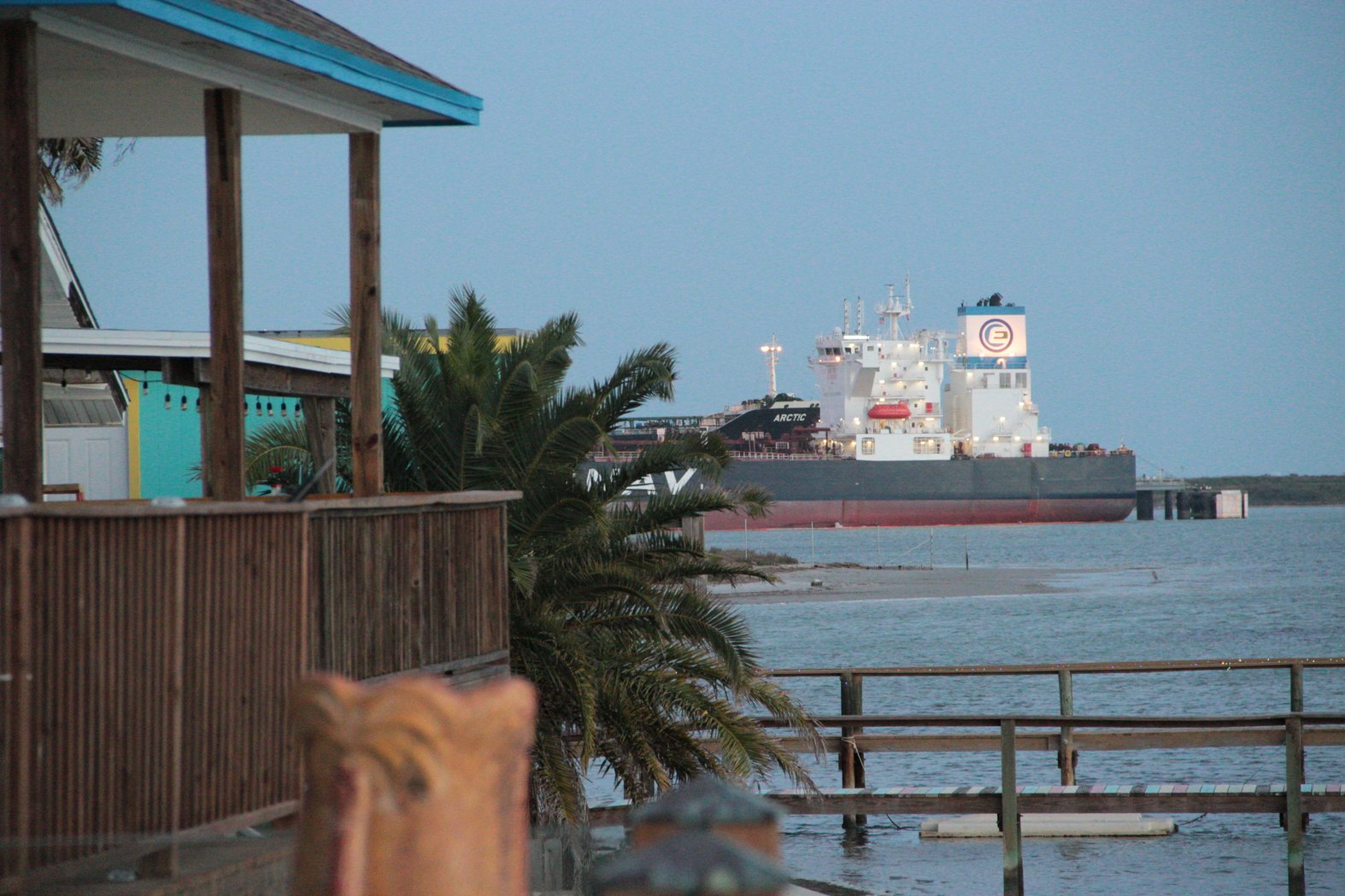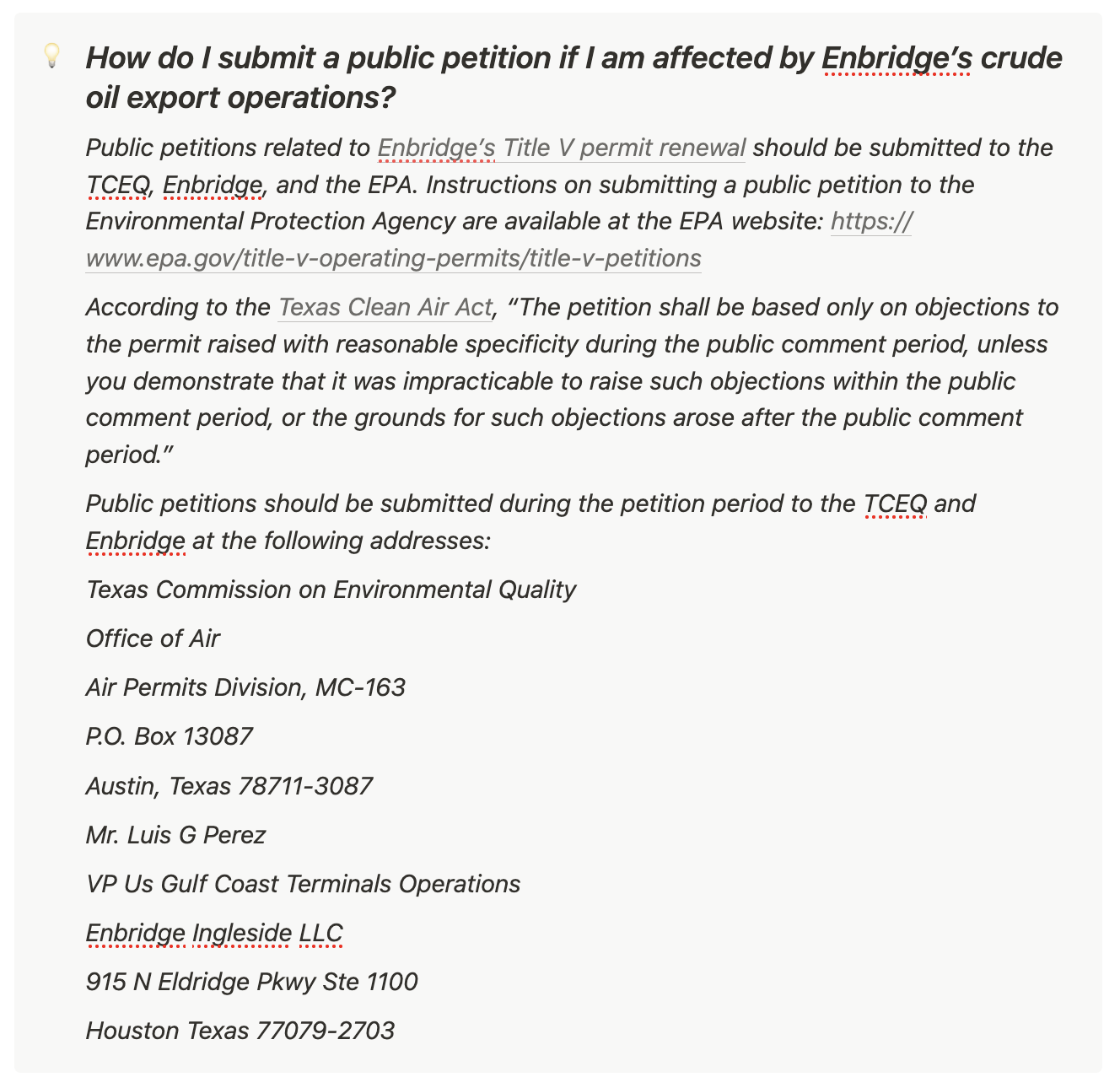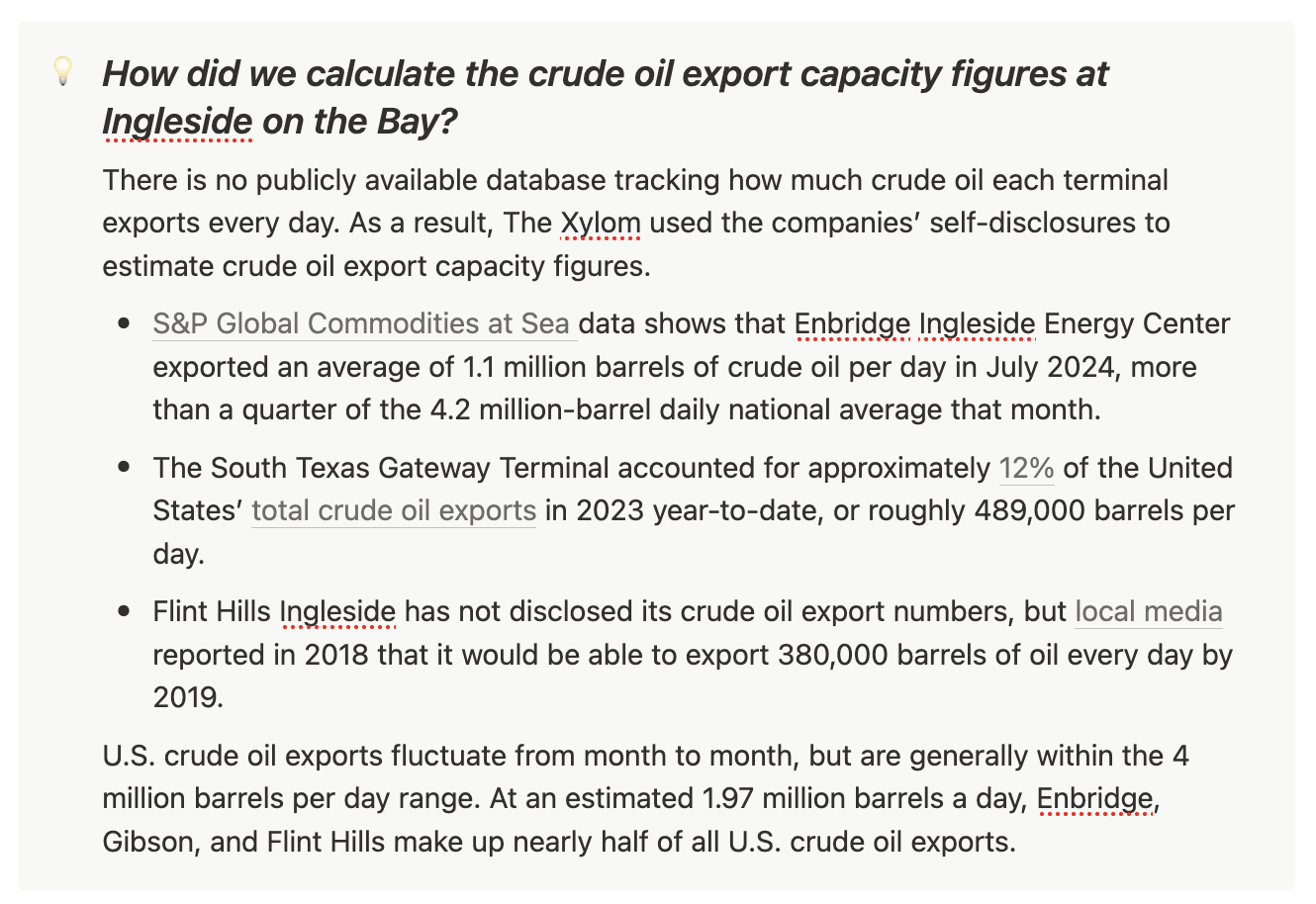
Photo: Cap Port Arthur, a Suezmax oil tanker currently sailing under the flag of Greece, looms behind a beach house at Ingleside on the Bay, Texas, on January 10th, 2024. (Alex Ip/The Xylom)
This is the first story of a three-part series produced by The Xylom and co-published by Drilled, Floodlight, and Deceleration News.
On Jan. 6th, 2024, nine minutes before midnight, the police department in Ingleside, Texas, uploaded on Facebook a now-deleted public advisory about a local oil spill.
“Flint Hills-INGLESIDE is reporting a release at one of their tanks. They have reported that it is all contained onsite — but the odor is pretty strong.”
Overnight, the roughly 700 members of Facebook group Citizens of the City of Ingleside on the Bay were whipped into a frenzy. This is a group that usually posts about scavenger hunts, Girl Scout cookie sales, and carpenter requests.
“I just walked outside to my backyard and I’m smelling the gaseous odor. Is anyone else experiencing this?” asked Diane Vega.
“Burning eyes!!!” replied Lynne Porter, who was then weeks away from retiring from her position as the Assistant Superintendent of the Ingleside, Texas, Independent School District.
“It was horrible last night also. We turned off the fans on our HVAC to decrease the probability we would have the odor in our house,” said town pharmacist Idana Merrick.
Ingleside on the Bay is a small seaside town with 614 residents in San Patricio County, Texas. It is a semi-enclave of Ingleside — on which it relies for certain basic services — and has a front-row seat to the north shore of Corpus Christi Bay, which Mount Rushmore sculptor Gutzon Borglum described as “the most beautiful bay on the Texas coast.” Until recently, residents could squint on a good day and see the skyline of Corpus Christi, the self-proclaimed “Gulf Coast Capital” with over 300,000 residents, ten miles across the Bay.


Top: Beach houses lined up along Ingleside on the Bay’s shoreline. Bottom. A dog runs across The Brass Turtle Lodge. Just 2,600 feet away from Enbridge Ingleside Energy Center, it is Ingleside on the Bay’s closest property to the crude oil export terminals. (Alex Ip/The Xylom)
By all measures as of the last decennial census, Ingleside on the Bay is the opposite of the stereotypical frontline community: over 80% of the town’s residents are white as of the last decennial census; most have health insurance to deal with the immediate and long-term impacts of the polluted air they breathe, the polluted shoreline they walk on, and the polluted water they fish and swim in. Every resident I’ve talked to is semi-retired; some have multiple properties and can move out of town at a moment’s notice.
As a result of being a demographic outlier compared to other more notable fenceline communities, in each of the past three Presidential elections, Ingleside on the Bay’s precinct went for Donald Trump by at least a fifty-point margin.
But Ingleside on the Bay, which, according to the Zillow Home Value Index, has the second-highest home values in the Corpus Christi metro area, has become America’s crude oil export capital almost overnight. Residents still couldn’t believe their fate.
“Before I signed on the dotted line, we drove over there with my realtor and said, ‘Are you planning on doing anything?’ No, they weren't going to expand, they weren't going to do anything,” recalls Suzi Wilder, an RV park owner and Ingleside on the Bay City Alderman.
“Well, they didn't tell us they were going to sell!”

Large marine vessels serving the burgeoning oil and gas industry are common sights at Ingleside on the Bay, Texas. (Alex Ip/The Xylom)
Within a two-mile radius of Ingleside on the Bay’s City Hall are three such massive crude oil export terminals. Immediately east of aquamarine waterfront mansions is Enbridge Ingleside Energy Center, the largest crude oil storage and export terminal by volume in the U.S. The site of the spill, Flint Hills Resources Ingleside Terminal, is on Enbridge’s right. Beyond Flint Hills is Gibson South Texas Gateway, America’s second-largest crude oil export facility. Together, they make up nearly half of all U.S. crude oil exports – an estimated over 700 million barrels in 2024.

For the past six years, the U.S. has produced more crude oil than any other country at any point in history. More than a third of that is transported through a crisscrossing network of pipelines to crude oil export terminals, where the oil is loaded into tankers and exported to various countries.
Ingleside’s three facilities are putting the U.S. the closest it has been to becoming a net crude oil exporter for the first time since the early seventies, a longtime goal of energy independence advocates. But the economic, health, and environmental costs are grave: toxic air and water, dead sea animals, physical restrictions from accessing the water for fishing or recreation, pungent odors, nausea, and even asthma.

Locals are putting up a last stand: If they succeed, they will be the first in Texas to do so. If they fail, Ingleside on the Bay may well end up a ghost town — one more of the countless casualties from cycle after cycle of oil and gas exploitation.
“Ingleside on the Bay is our slice of heaven that you’re willing to turn into hell for a profit,” said Kelley Burnett, who captains the local dolphin boat tours.
“This is not just about our health, but our livelihood.”
AirPods in her ears to block out the noise, Lynne Porter runs along Bayshore Drive just four days after the Jan. 6th spill.

Lynne Porter (right) speaks to former Coastal Watch Association Executive Director Cyndi Valdes (left) as she takes a break from her afternoon jog. (Alex Ip/The Xylom)
Since she moved from down the bay three years ago, what Porter sees, smells, and breathes in has worsened dramatically. Now she requires an inhaler to get through her day, yet she still insists on keeping her pace along the water’s edge: she’s been a runner her whole life.
Porter’s route turns back at the Brass Turtle Lodge a few feet away from a chicken-wire fence that demarcates the town’s easternmost boundary from McGloin’s Bluff, a buffer zone from Enbridge. On that day, she runs into her neighbor Cyndi Valdes, who was the Coastal Watch Association’s Executive Director at the time.
Looking through the fence across McGloin’s Bluff, all 909 feet of Cap Port Arthur looms. The 156,600-ton oil tanker would depart Enbridge on the morning of Jan. 15th, 2024, taking a 19-day voyage along the Gulf of Mexico and the Atlantic to Valero’s Jean Gaulin Refinery, in Levis, Canada, where the St. Lawrence River narrows. Porter and Valdes both notice fumes from crude oil loading permeating the air.

Looking from Ingleside on the Bay’s easternmost boundary, crude oil is loaded into Cap Port Arthur, a Suezmax oil tanker currently sailing under the flag of Greece, at the Enbridge Ingleside Energy Center on January 10th, 2024. McGloin’s Bluff, a site containing various Indigenous artifacts, is in the foreground. (Alex Ip/The Xylom)
Students at MIT looked at the Risk Screening Environmental Indicators around Corpus Christi for The Xylom. They found that in the last few years, toxic pollution risk dramatically shifted from the south shore, where Corpus Christi and Nueces County is located, to the north, where Ingleside on the Bay and San Patricio County is located.
The Risk Screening Environmental Indicators data, published by the U.S. Environmental Protection Agency, “account for the size of a chemical release, the fate and transport of a chemical within the environment, the size and location(s) of potentially exposed populations, and a chemical’s relative toxicity.” Higher RSEI scores indicate higher potential for risk-related impacts.
The 2022 RSEI score in Nueces County declined almost 30% from its peak in 2018, whereas San Patricio County’s increased nearly seventeen-fold from 2018, exceeding Nueces County for the first time.

Valdes joined Ingleside on the Bay Coastal Watch Association as its first Executive Director in March 2023, the same month Enbridge and the Norwegian chemical company Yara announced Project YaREN, a nearly-$3 billion ammonia facility built on the last slice of undeveloped land, NS Ingleside’s old fire station.
Under her leadership, the nonprofit renamed itself the Coastal Watch Association to reflect the opening up of its membership to nearby townspeople, put up a highway billboard warning locals of the potential health risks of Project YaREN, and joined the Coastal Action Network, a grassroots coalition serving marginalized and fenceline communities across the Coastal Bend.
However, Ingleside on the Bay residents are learning what their new allies already knew: regardless of race, ethnicity, political leaning, or educational background, money is always a big part of the uphill climb for fenceline communities.
The Coastal Watch Association has successfully sought grants worth tens and hundreds of thousands from national philanthropies like the Rockefeller Family Fund, the Environmental Defense Fund, and Beyond Petrochemicals, many of which are fearing the possible retaliatory revoking of tax-exempt statuses by the Trump administration due to their support of environmental causes.

Resident jetties pale in comparison in scale to the Enbridge Ingleside Energy Center’s docks, which are designed for Very Large Crude Carriers. (Alex Ip/The Xylom)
Yet, the crude oil that passed through the three export terminals in 2023 alone was worth roughly $50 billion, or more than the entire GDP of the state of Wyoming, the largest coal producer in the U.S. In June 2023, Gibson forked over $1.1 billion in cash to purchase the South Texas Gateway from Buckeye. Enbridge additionally closed a $200 million purchase of Flint Hills Ingleside from a Koch Industries subsidiary in November as part of an arms race with its competitors along the Gulf Coast. (For the purpose of clarity, the Flint Hills Resources Ingleside Terminal assets purchased by Enbridge, where the oil spill occurred, are referred to as “Flint Hills Ingleside” in this story.)

San Patricio County residents opposed to oil and gas, who number at most in the thousands, now also have to grapple with foreign corporations hoping to take a slice of the pie. The first owners who built the export terminals, Moda, Oxy, and Buckeye, are all based in Houston; angry residents wishing to picket at their headquarters could get there in a few hours. Enbridge and Gibson, the new owners in town, are based in Calgary, Canada. Yara even signaled that Project YaREN would take advantage of U.S. subsidies and cheap natural gas to make low-carbon “blue” ammonia and export it exclusively to Europe.
“When Oxy had it, we didn't have any problems. Then Moda came, we had more problems the more ships were coming. And then Enbridge comes in? All hell breaks loose!” says Wilder, the City Alderman.
Port Corpus Christi and the U.S. Army Corps of Engineers have spent nearly half a billion dollars deepening the La Quinta Channel to match the width of the Corpus Christi channel and allow two vessels to pass by each other.
“So they can come in here, dump the oil, and get back out and make more money,” Charlie Boone, the President of the Coastal Watch Association, quips.
Residents were promised that dredging would not affect views or access to the Bay. However, a six-foot-tall spoil island formed outside resident jetties, even blocking the Corpus Christi skyline. White foamy gunk started floating on the water. Dead sea turtles and grounded seabirds washed ashore.
“We used to have tons of crabs, but we don’t have crab life anymore. The fish are a lot less,” says Wilder, who has lived yards from the chicken wire fence since 2016. “I remember calling Cindy, ‘You better see this!’ We had so much weight here. Not at all this year.”
Wilder told me that when she was on the beach during one Fourth of July Weekend, her silver ring immediately turned black after rubbing it in the sand, indicating an abnormal presence of strongly oxidizing substances.

Suzi Wilder describes how the environs surrounding her jetty at Ingleside on the Bay, Texas, have changed, as an oil tanker passes behind her. (Alex Ip/The Xylom)
Flint Hills’ 2024 spill ultimately totaled around 2,900 barrels of oil. When reached for comment, Jake Reint, Flint Hills’ Vice President of Public Affairs, pushed back against San Patricio County Emergency Management’s characterization of the incident as an “oil spill”; however, the EPA also used the term in a 2024 order.
Although the oil was contained on land and did not enter the Bay, Porter and Valdes say they are alarmed by this being the second spill during that week that affected their health. The first: A truck hit a valve at the Shamrock Terminal at Port of Victoria on Jan. 3rd, 2024, releasing an estimated 500 barrels of waste oil containing crude oil, solvents, and mercaptan, a colorless, flammable, and foul-smelling gas.
The sulfurous odor swept 60 miles downwind.
“My husband normally doesn’t call me when I’m out of town,” Porter recalls. “When he calls me, he says, ‘Something’s badly wrong. It smells horrible. It’s in my eyes. I can’t breathe! The dogs are reacting, they wouldn’t go out, they’re all huddled together.’ ”
The EPA wasn’t notified about the spill for over 24 hours. Shamrock Products didn’t issue a press release until three days later, on Saturday, Jan. 6th, just as residents were busy confronting the Flint Hills oil spill.
“Now if we had a major mishap. How the hell are they going to contain it?” Wilder asks.
The next day, Valdes drives me near the Brass Turtle Lodge to meet up with Wilder, the City Alderman.
Wilder used to live in nearby Taft, close to a crop duster airfield. She suspects that her skin cancer was connected to being exposed to the chemicals daily. Recently her skin cancers have multiplied, requiring biopsies every three months to monitor the condition. Wilder has even asked Valdes to accompany her to get surgery.
Despite her elected position giving her access to representatives from Enbridge, Flint Hills, and Gibson, Wilder doesn’t mince words regarding her personal views of her neighbors.
“They do come speak, but they don’t tell the truth,” she says, as an Odfjell tanker slowly passes behind her. “They sugarcoat everything and blow smoke up where the sun don’t shine. So it’s kind of sad.”
Driving along Sandpiper Drive and turning right into Starlight Drive, Ingleside on the Bay City Hall comes into view. A single-story, steel-clad structure, it doubles as the fire station. The town can’t afford to pay firefighters to man the couple of firetrucks sitting at the back; they can’t afford the personal protective equipment to deal with chemical fires or hazardous spills either.

ngleside on the Bay City Hall, with a firetruck shed attached to the building’s back. (Alex Ip/The Xylom)
Starlight Drive meets Main Street, an unlit two-lane road and the only land escape route. Turning right at the intersection leads to the main entrances of Enbridge, Flint Hills, and Gibson. A mile down the left is the Marine Spill Response Corporation.
To become a customer of the Corporation, a company must sign up for the Marine Preservation Association (MPA), a nonprofit consortium of over 1400 oil and gas company members that funds the Corporation. The Corporation is activated to clean up large-scale oil spills upon member request, or occasionally, the U.S. Coast Guard. Municipalities, which cannot be members by default, could only deploy the Corporation’s services after they prove they could foot the bill — a heavy lift for Ingleside on the Bay’s minuscule tax base, especially in a life-or-death situation.
And it’s not like Ingleside on the Bay could get help from its neighbors. Wilder recalled attending a recent State of the County meeting, where two towns each brought one truck operated by one firefighter. If fighting chemical fires or hazardous spills is a nonstarter, what about evacuating the kids, asks Porter, who still prioritizes her former students.
“They are not [evacuating]!” Valdes retorted. “They’d have to shelter in place, so they’d be dead.”
In an email response to The Xylom, Jake Reint, Flint Hills’ Vice President of Public Affairs, wrote, “Flint Hills has partnered with the Refinery Terminal Fire Company, which provides services to protect local industry and the community from hazardous fire incidents at the Ingleside Terminal. Additionally, our Helping Heroes program offers grants to emergency responders in San Patricio County.”
Instead of turning left and taking the direct route to our next location, Valdes turns right at Main Street. Valdes and Wilder wanted to show me how the lack of monitoring and enforcement has emboldened Flint Hills and Enbridge’s operations.
“I’m starting to smell Flint Hills, aren’t you?” Valdes asks me.
Immediately, it’s as if the lights in the room are dimmed: rows and rows of crude oil storage tanks, some made of concrete, some fitted with aluminum geodesic domes, line the horizon. The obelisks of the petrochemical industry juxtapose in stark contrast with the seemingly undisturbed vegetation and sandy bluffs in the future expansion and buffer zones.
“I try not to go down here,” Valdes gestures. My head began thumping. Truck after loaded truck passes us under the dull grey sky outside Enbridge, Flint Hills, and Gibson.

The Falcon Refinery Superfund site in Ingleside, Texas, January 2024. (Alex Ip/The Xylom)
Wilder turns left onto Farm-to-Market Road 2725, which parallels the water. The Falcon Refinery Superfund site comes into view. Twenty years have passed since the EPA began evaluating how contaminated the abandoned refinery is; there is no timetable for when remedial action will start.
For residents, it’s a sobering reminder of how long-lasting the negative environmental effects of petrochemical facilities could be, even decades after their closure.
“That’s the thing with this industry,” concludes Wilder. “They’re not out to protect this town.”
This is the first story of a three-part series produced by The Xylom and co-published by Drilled, Floodlight, and Deceleration News. Read Part 2 here now and hear more from Alex on this story on the podcast here.
Reporting of this story was supported by the Society of Environmental Journalists, Institute for Journalism and Natural Resources and the Kelly-Douglas Fund at the MIT School of Humanities, Arts, and Social Sciences. Lai Wa Chu and Jaime Diaz contributed research to the story.
